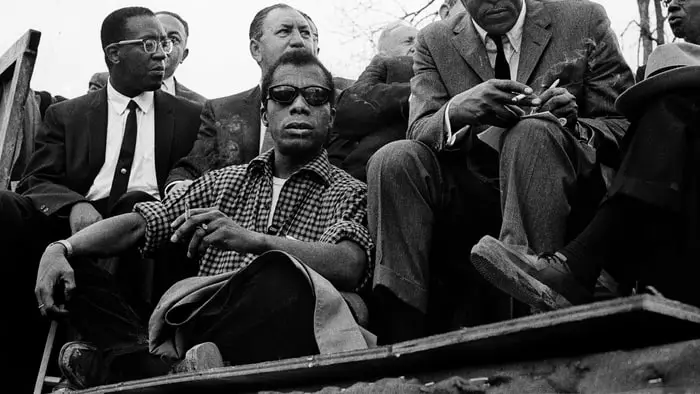This past February, “I Am Not Your Negro” was released to select theaters across the United States. Part biographic, part documentary, all Baldwin—where “all” means that the narration, which is read by Samuel L. Jackson, comes directly from Baldwin’s writing. The film is based predominately on the unfinished draft of Baldwin’s last novel, “Remember This House,” concerning his relationships with civil-rights activists Medgar Evers, Malcolm X and Martin Luther King Jr. Several excerpts from Baldwin’s other works are peppered throughout, all accompanied by film and images that pertain to his sharp words.
“I Am Not Your Negro” is prophetic. Or rather, Baldwin was prophetic in his criticisms of race relations, American culture and what it would take to have peace between the two. Instead of focusing attention on the political and bureaucratic systems that had racist policies, Baldwin called for attention toward the culture of America, which is an entirely different approach to the issue of racial inequality that many believe was solved in the ’60s. In a de juris sense, yes, it was, but a quick scroll through Twitter would prove that we’ve a long way to go.
In looking through discussions on race on social media sites, there still seems to be distance between white and black people, both of which are rooted in a fear of the other. The observations Baldwin made through the ’60s and ’70s seem to offer the most sensible explanation, and it’d be worth taking them into consideration.
The Civil Rights movement directly contributed to the destruction of policies that created segregation, but to Baldwin and so many other activists, the movement was simply not enough. The author speaks on this multiple time throughout the film, but most directly while giving a lecture in London in 1969. Citing the already established policies to “fix” segregation, Baldwin urges the audience to look at the situation itself. “What you have to look at is what is happening in this country, and what is really happening is that brother has murdered brother knowing it was his brother. It is not a racial problem, it is a problem of whether or not you’re willing to look at your life and be responsible for it and then begin to change it.”
Images of the riots that broke out in Ferguson, Missouri, and Baltimore, Maryland, in response to the deaths (and subsequent handling of the deaths, in which the police officers involved received no charges) are heavily featured in the film. The several pictures and videos from the Civil Rights Movement contrast the aforementioned riots only in the color they were shot in.
In one scene, King is being escorted through a crowd of demonstrating white-supremacist protestors. Grown men and children alike are brandishing crudely made signs and wearing American flags on their bodies as King avoids being pelted with whatever the protestors have on hand. Protestors clutch bottles of Coca-Cola and hold up signs with “White Power” and swastikas on them. It’s a powerful image: Coca-Cola, a symbol of Americana, beside the mark of the most dangerous ideology as if the two go hand in hand.
When the government finally began focusing on race relations, defined then as “The Negro Problem,” Baldwin says that the concern was disingenuous, and more likely done out of guilt. The guilt that motivated these changes, instead of being brought on by realizing the pain that their unjust policies had inflicted upon the black population, was from wanting to shed the ugly image it cast upon the majority of America’s white population.
An example of this is the entertainment industry’s partaking in tokenism, or using a member of a minority group as a way to show diversity in a show’s cast. Baldwin himself criticized the film industry as perpetuating this segregation, in the form of casting minorities as enemies or lesser characters. The practice is exemplified in Old West movies, such as the cowboy versus Indians trope that made actors like John Wayne and Gary Cooper beloved stars.
Baldwin described this instance of art reflecting life as destroying a black person’s reality, when so many of these films depicted white heroes killing scores of Native Americans. “It comes as a great shock around the age of five, or six, or seven, to discover that Gray Cooper killing off the Indians, when you were rooting for Gary Cooper, that the Indians were you. It comes as a great shock to discover the country, which is your birthplace, and to which you, your life and identity, has not, in its whole system of reality, evolved any place for you,” writes Baldwin.
Thanks to movements such as #BlackLivesMatter and investigative journalism that’s revealed blatant gerrymandering, profiling and other instances of systemic racism in government, race relations in the United States have received more attention. Most Americans question why such inequalities still exist, and with good reason; the unfortunately regular killings of black men and women by police with no repercussions, housing laws that disproportionately affect minority populations and public encounters with blatant racists are impossible to ignore.
At the beginning of the film, a segment of Baldwin during his guest appearance on the “Dick Cavett Show” is played. Cavett asks if there’s any hope for race relations to improve in America, to which Baldwin admits, making Cavett visibly uncomfortable, that he doesn’t have hope so long as the word “negro” keeps being used. “It’s not a question of what happens to the Negro here…the real question is what’s going to happen to this country. I have to repeat that,” he says.
Baldwin’s exhaustion at being asked the question is seen during his other guest appearances, even putting his face into his hand mid-sentence. It’s as if the statement was just as profound as the first time he thought of it, or maybe he thought answering was pointless; he may have thought they hadn’t listened anyway.
With this in mind, one cannot blame Malcolm X for his radical approach to change, nor King’s nonviolent perseverance: both had realized that a lifetime of activism could produce little to no results, seeing culture was harder to change than law. Baldwin was the gap between the two: his exposition is the growing frustration at why “white versus black” is even an issue at all, and the psychological burden it cast down on black people was perhaps the most difficult aspect to overcome.
Baldwin’s most damning observation is at the concept of the American dream and its relation happiness. “The American way of life has failed to make people happier or make them better. We do not want to admit this, and we do not admit it. We persist in believing that the empty and criminal among our children are the result of some miscalculation in the formula that can be corrected.”
This is something I believe every American citizen has experienced or participated in at a subconscious level, and it may explain why people are so quick to cite history and policies as solutions to problems they believe no longer exist.
I watched the film on a flight from London to Dallas. I spent the first hour-and-a-half of the nine-hour flight watching the film, and the rest of the time trying not to break the tray table. I could never imagine the frustration Baldwin and other activists felt at the time of the Civil Rights movement, but this film gives you an idea.
Comparing this film to the incredible literature written by Baldwin is a disservice: defining the film as literature would lend it as a piece to interpret. Rather, the film should be approached as an unedited history textbook, presented as it was (is), using only Baldwin’s voice.
The largest takeaway from this film is not trying to explain how to resolve race relations in the United States or that the country is hopeless for any solution. Instead, Baldwin zooms out to space and shows the gravity of the situation. It is my assumption that Baldwin was frustrated by his observation, and though he never lost hope that there could be change, he did know “that no matter how it comes about, it will be bloody, and it will be hard.”
I’ve given the skeleton of the film’s life, but watching it will give you the nerve as only Baldwin can. This is a film for the experienced and new Baldwin reader, anyone interested in learning more about the Civil Rights movement and those who still believe that American can become a nation with justice for all.
Baldwin never saw America’s first black president, the riots in Ferguson and Baltimore and so many other cities or the #BlackLivesMatter movement, but all were events he saw coming. I came away from this film knowing more about race culture in America than I ever did; and, in a way, how little I know about anything at all.
I hope this country is going more forward than backward. With this state of limbo my thoughts are in, I’m missing Baldwin and his ability to make sense of everything he paid mind to. But, like any great teacher, Baldwin has given us the tools and thrown us out, leaving his students to build the future he would never see.


















You’re right you’re not my negro you’re my cotton pickin nigger who has no rights because I own you.